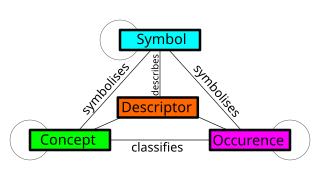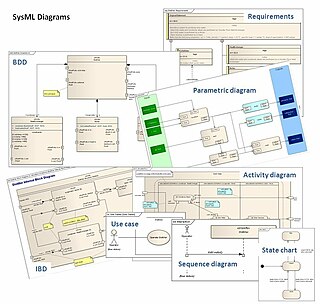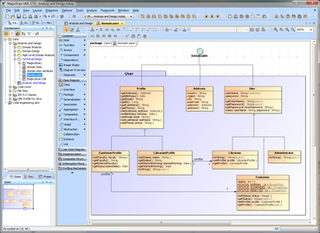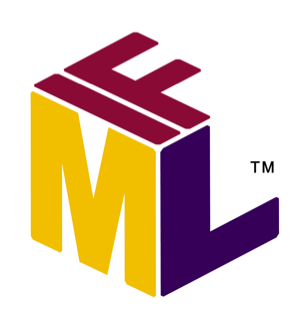The XML Metadata Interchange (XMI) is an Object Management Group (OMG) standard for exchanging metadata information via Extensible Markup Language (XML).
Model Driven Architecture (MDA) is a software design approach for the development of software systems. It provides a set of guidelines for the structuring of specifications, which are expressed as models. Model Driven Architecture is a kind of domain engineering, and supports model-driven engineering of software systems. It was launched by the Object Management Group (OMG) in 2001.

A metamodel is a model of a model, and metamodeling is the process of generating such metamodels. Thus metamodeling or meta-modeling is the analysis, construction, and development of the frames, rules, constraints, models, and theories applicable and useful for modeling a predefined class of problems. As its name implies, this concept applies the notions of meta- and modeling in software engineering and systems engineering. Metamodels are of many types and have diverse applications.
Model-driven engineering (MDE) is a software development methodology that focuses on creating and exploiting domain models, which are conceptual models of all the topics related to a specific problem. Hence, it highlights and aims at abstract representations of the knowledge and activities that govern a particular application domain, rather than the computing concepts.

The systems modeling language (SysML) is a general-purpose modeling language for systems engineering applications. It supports the specification, analysis, design, verification and validation of a broad range of systems and systems-of-systems.

MagicDraw is a proprietary visual UML, SysML, BPMN, and UPDM modeling tool with team collaboration support.
Visual modeling is the graphic representation of objects and systems of interest using graphical languages. Visual modeling is a way for experts and novices to have a common understanding of otherwise complicated ideas. By using visual models complex ideas are not held to human limitations, allowing for greater complexity without a loss of comprehension. Visual modeling can also be used to bring a group to a consensus. Models help effectively communicate ideas among designers, allowing for quicker discussion and an eventual consensus. Visual modeling languages may be General-Purpose Modeling (GPM) languages or Domain-Specific Modeling (DSM) languages. Visual modelling in computer science had no standard before the 90's, and was incomparable until the introduction of the UML. They include industry open standards, as well as proprietary standards, such as the visual languages associated with VisSim, MATLAB and Simulink, OPNET, NetSim, NI Multisim, and Reactive Blocks. Both VisSim and Reactive Blocks provide a royalty-free, downloadable viewer that lets anyone open and interactively simulate their models. The community edition of Reactive Blocks also allows full editing of the models as well as compilation, as long as the work is published under the Eclipse Public License. Visual modeling languages are an area of active research that continues to evolve, as evidenced by increasing interest in DSM languages, visual requirements, and visual OWL.
A profile in the Unified Modeling Language (UML) provides a generic extension mechanism for customizing UML models for particular domains and platforms. Extension mechanisms allow refining standard semantics in strictly additive manner, preventing them from contradicting standard semantics.
Rational Rhapsody, a modeling environment based on UML, is a visual development environment for systems engineers and software developers creating real-time or embedded systems and software. Rational Rhapsody uses graphical models to generate software applications in various languages including C, C++, Ada, Java and C#.
Modeling and Analysis of Real Time and Embedded systems also known as MARTE is the OMG standard for modeling real-time and embedded applications with UML2.
SysML Partners is a consortium of software tool vendors and industry leaders organized in 2003 to create the Systems Modeling Language (SysML), a dialect of UML customized for systems engineering. The consortium was founded and organized by Cris Kobryn, who previously chaired the UML 1.1 and UML 2.0 specification teams, and Sandy Friedenthal, chair of the OMG Systems Engineering Special Interest Group. The SysML Partners defined SysML as an open source specification, and their specifications include an open source license for distribution and use.
EAST-ADL is an Architecture Description Language (ADL) for automotive embedded systems, developed in several European research projects. It is designed to complement AUTOSAR with descriptions at higher level of abstractions. Aspects covered by EAST-ADL include vehicle features, functions, requirements, variability, software components, hardware components and communication. Currently, it is maintained by the EAST-ADL Association in cooperation with the European FP7 MAENAD project.

Modelio is an open-source UML tool developed by Modeliosoft, based in Paris, France. It supports the UML2, BPMN and ArchiMate standards.

YAKINDU Statechart Tools (YAKINDU SCT) is a tool for the specification and development of reactive, event-driven systems with the help of finite-state machines. It comprises a tool for the graphical editing of statecharts and provides validation, simulation, and source code generators for various target platforms and programming languages. YAKINDU Statechart Tools are available with standard and professional editions, with no-cost licenses for non-commercial resp. academic usage. Users are coming from both industry and academia.

The Interaction Flow Modeling Language (IFML) is a standardized modeling language in the field of software engineering. IFML includes a set of graphic notations to create visual models of user interactions and front-end behavior in software systems.

Sparx Systems Enterprise Architect is a visual modeling and design tool based on the OMG UML. The platform supports: the design and construction of software systems; modeling business processes; and modeling industry based domains. It is used by businesses and organizations to not only model the architecture of their systems, but to process the implementation of these models across the full application development life-cycle.
Model-based systems engineering (MBSE), according to the International Council on Systems Engineering (INCOSE), is the formalized application of modeling to support system requirements, design, analysis, verification and validation activities beginning in the conceptual design phase and continuing throughout development and later life cycle phases. MBSE is a technical approach to systems engineering that focuses on creating and exploiting domain models as the primary means of information exchange, rather than on document-based information exchange. MBSE technical approaches are commonly applied to a wide range of industries with complex systems, such as aerospace, defense, rail, automotive, manufacturing, etc.
UML Designer is an open-source UML tool based on Sirius and Eclipse. The project is licensed under the EPL.

Capella is an open-source solution for model-based systems engineering (MBSE). Hosted at polarsys.org, this solution provides a process and tooling for graphical modeling of systems, hardware or software architectures, in accordance with the principles and recommendations defined by the Arcadia method. Capella is an initiative of PolarSys, one of several Eclipse Foundation working groups.








